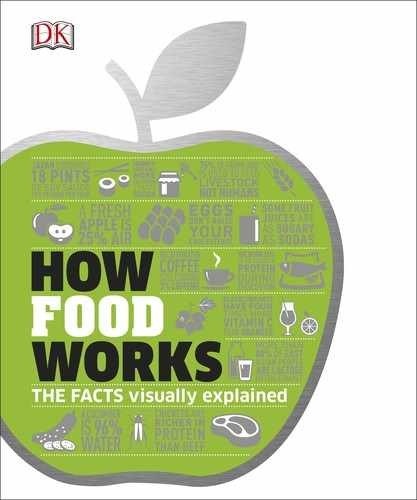
TYPES OF FOOD
Meat substitutes
Meat substitutes
Consumers prize meat for its flavor, texture, and
nutritional value, but many are concerned by the
negative health, environmental, and ethical impacts
of meat consumption and production. One solution
to these problems is the use of increasingly popular
meat substitutes.
Using meat substitutes
Although meat substitutes might
seem like a modern trend related to
health benefits, they have actually
been popular since ancient times
through cultural and religious
prohibitions against meat. For
example, tofu was created in ancient
China by vegetarian Buddhists. Today
the primary sources of meat substitute
are soy-based products, gluten-based
products from grains, the use of other
protein sources such as nuts, and, as
shown here, the controlled growth
of mycoproteins from fungi.
COOLING SYSTEM
Ammonia and air added
Fungal growth is boosted
by adding nitrate from ammonia
and oxygen from air. These gases
are bubbled through the mixture
to help mix it.
Mycoprotein
grows
For about six weeks the
mycoprotein continues to
cycle around the fermenter
and grow. Eventually, it
collects in a chamber and
is then harvested.
2
5
Fungus, glucose,
and minerals added
A starter culture of the fungus Fusarium
is added to a fermentation tank. It needs
food to metabolize into protein, so
sterilized glucose syrup is
added to the tank, along
with trace minerals.
1
Cooling down
The rapid growth of the
fungus, and its constant metabolism,
generate lots of heat. Coils of cooling
water help to maintain the optimum
temperature for fungal growth.
4
HEAT
TREATMENT
DRYING AND
CHILLING
MYCOPROTEIN COLLECTS
Glucose added
Trace
minerals added
Starter culture
of fungi added
SAUSAGE
SLICES
Finished products
Harvested mycoprotein
is heated to neutralize harmful
substances, spun in a centrifuge
to dry, and is then chilled. The
mixture is also treated to make
it more closely resemble muscle
fibers, flavored, and shaped
into meatlike products, such
as sausages or slices.
6
HARVESTED
MYCOPROTEIN
Oxygen Nitrogen
H
O
W
M
Y
C
O
P
R
O
T
E
I
N
I
S
M
A
D
E
US_076-077_Meat_substitutes.indd 76 18/01/2017 09:43
76 77
TYPES OF FOOD
Meat substitutes
Tofu
Tofu, or bean curd, is made by
curdling soy milk to produce
curds, which are then broken
down to release water and
pressed into blocks.
Textured vegetable protein
Made from the by-products of
soy-bean oil processing,
textured vegetable protein
is a versatile meat
alternative.
Tofu skin
Heating soy milk creates a thin
but solid skin that traps oil.
Fibrous and chewy, it is
dried as sheets
or sticks.
Thousand layers tofu
A process of freezing then
thawing tofu creates a product
with a spongy network that
resembles many layers.
Versatility of soy
Soy is rich in proteins and oils, which makes
it an extremely useful base for meat substitutes.
Fermenting the soy releases its rich cargo of
nutrients and these can then be processed in
similar fashion to milk and dairy products. Many
different soya products have been developed.
IS MYCOPROTEIN
VEGAN?
Although pure mycoprotein
probably would be vegan,
most marketed products are
not because they use egg
white as a binder and milk
ingredients during
processing.
SOYBEANS
Waste gases
The air and ammonia
bubbled through the mixture,
along with waste gases
produced by the metabolism
of the fungus, are extracted
from the fermenting vessel.
3
IN 10TH CENTURY
CHINA, TOFU WAS
COMMONLY KNOWN
AS “SMALL MUTTON”
Gases
released
Mycoprotein (fungus)
starts to grow
US_076-077_Meat_substitutes.indd 77 18/01/2017 09:43

76 77
TYPES OF FOOD
Meat substitutes
Tofu
Tofu, or bean curd, is made by
curdling soy milk to produce
curds, which are then broken
down to release water and
pressed into blocks.
Textured vegetable protein
Made from the by-products of
soy-bean oil processing,
textured vegetable protein
is a versatile meat
alternative.
Tofu skin
Heating soy milk creates a thin
but solid skin that traps oil.
Fibrous and chewy, it is
dried as sheets
or sticks.
Thousand layers tofu
A process of freezing then
thawing tofu creates a product
with a spongy network that
resembles many layers.
Versatility of soy
Soy is rich in proteins and oils, which makes
it an extremely useful base for meat substitutes.
Fermenting the soy releases its rich cargo of
nutrients and these can then be processed in
similar fashion to milk and dairy products. Many
different soya products have been developed.
IS MYCOPROTEIN
VEGAN?
Although pure mycoprotein
probably would be vegan,
most marketed products are
not because they use egg
white as a binder and milk
ingredients during
processing.
SOYBEANS
Waste gases
The air and ammonia
bubbled through the mixture,
along with waste gases
produced by the metabolism
of the fungus, are extracted
from the fermenting vessel.
3
IN 10TH CENTURY
CHINA, TOFU WAS
COMMONLY KNOWN
AS “SMALL MUTTON”
Gases
released
Mycoprotein (fungus)
starts to grow
US_076-077_Meat_substitutes.indd 77 18/01/2017 09:43
..................Content has been hidden....................
You can't read the all page of ebook, please click here login for view all page.
